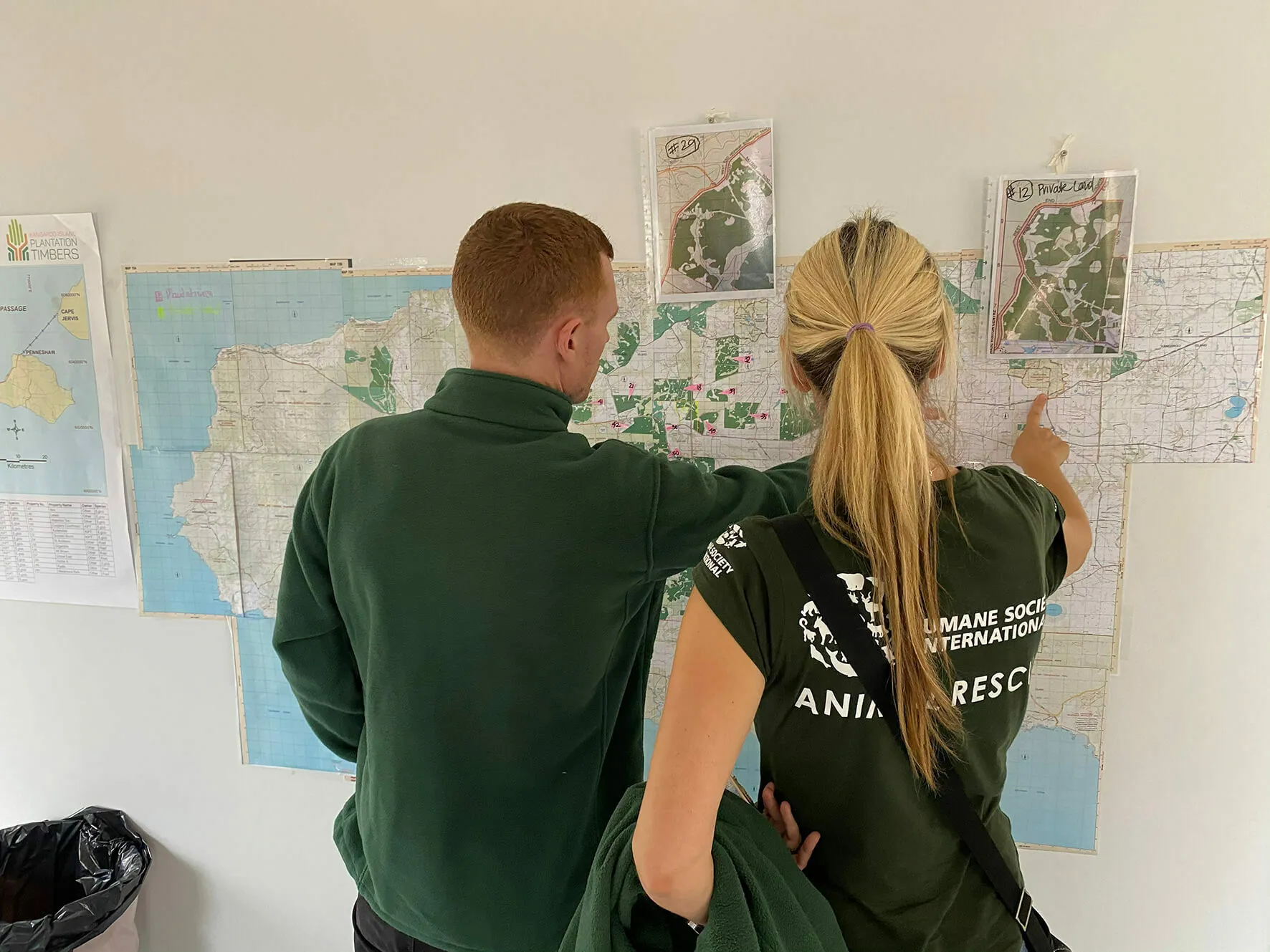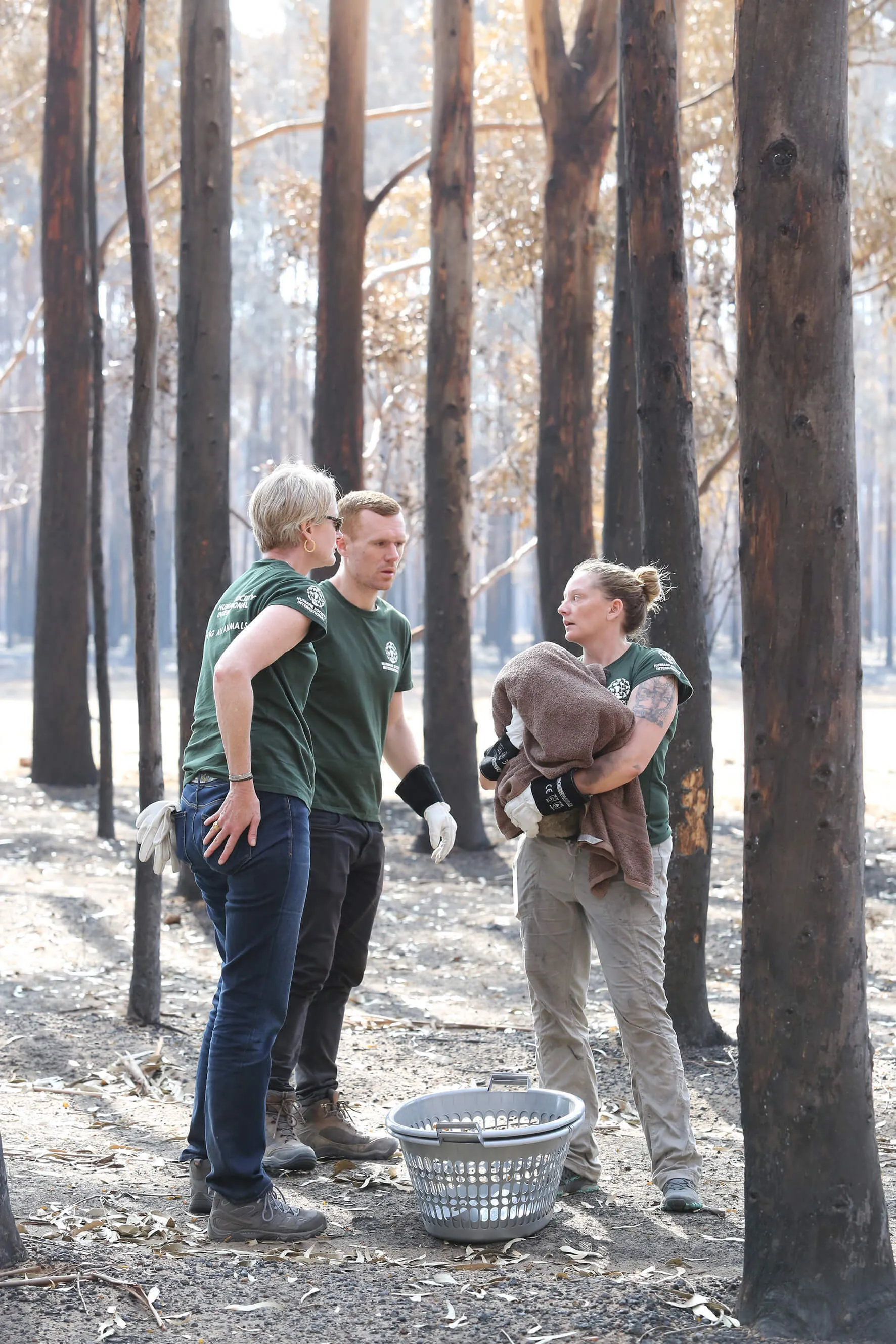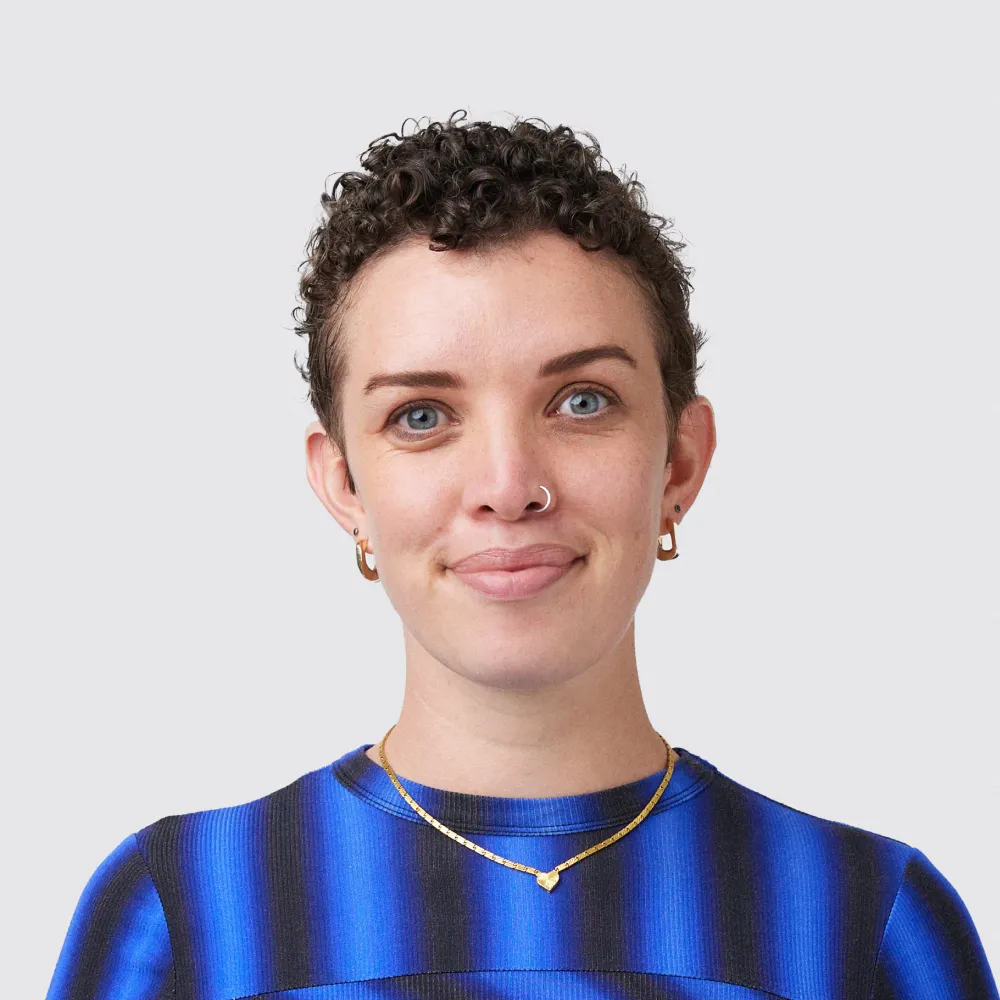As the recovery from the grievous fires that spread across Australia last summer continues, we’re all too aware that some parts of our beautiful country experienced it far worse than others. On Kangaroo Island, the effects are heart-breaking and recovery for flora and fauna alike will be slow, perhaps never being able to return to what it was before.
We spoke to Evan Quartermain, Head of Programs at Humane Society International AUS , and Douglas Thron, Infrared Drone Pilot, to learn more about their wildlife rescue missions and how they are using infrared drone technology to rescue our beloved koalas.
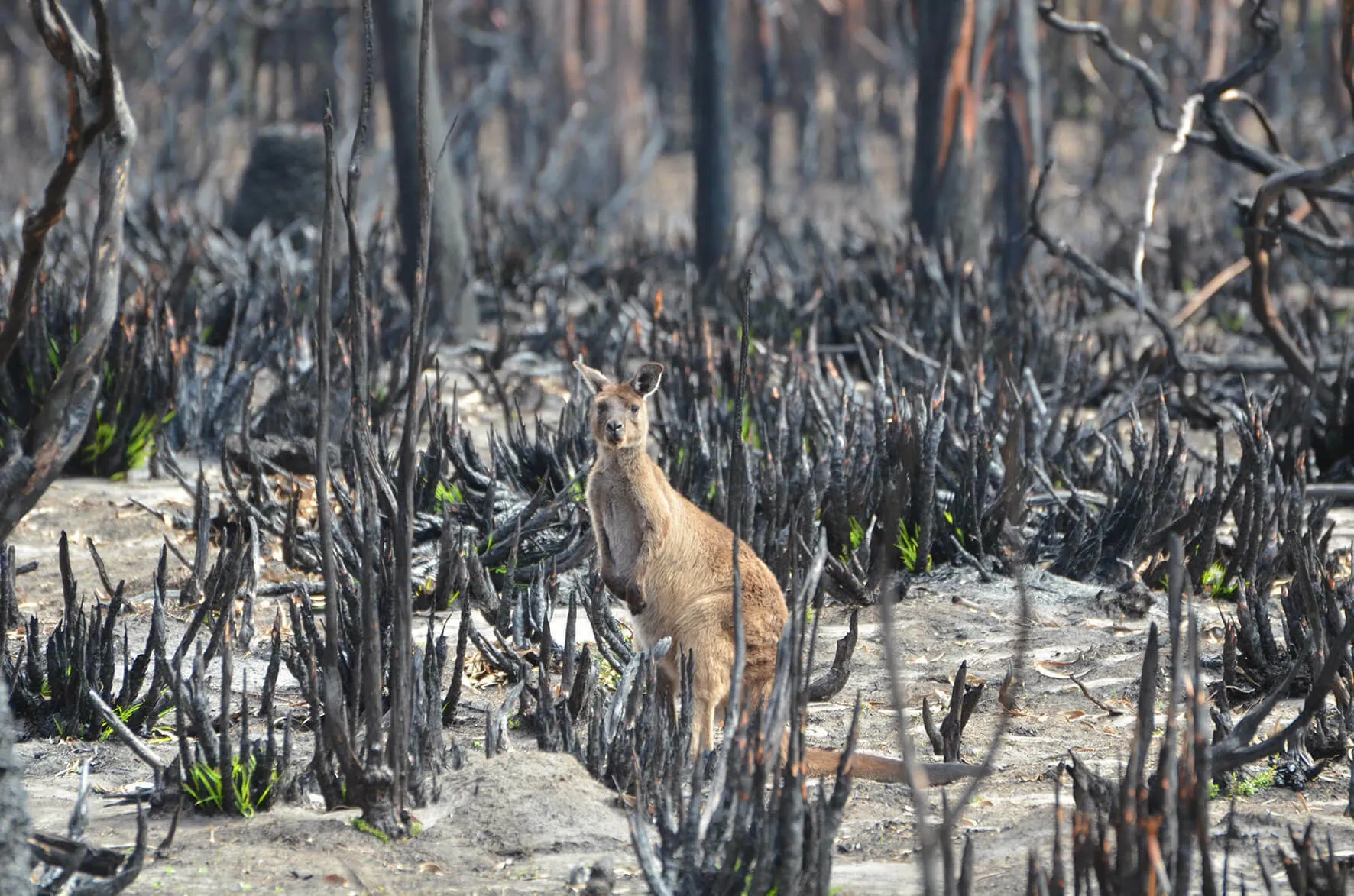
In conversation
Evan Quartermain, Head of Programs at Humane Society International AUS
Douglas Thron, Infrared Drone Pilot
Kate Bensen, Storyteller at Today
Could you give an intro to what the Humane Society International does and what your role is?
Evan: Humane Society International is one of the largest and most effective international charities working for a more humane and sustainable world for animals. We use our expertise to advocate for the protection of wildlife—including threatened species—and their habitats and reduce cruelty in farming, trade and other industries by raising public awareness, improving legislation that impacts animals and the environment, and directly engaging with farmers, landholders, and wildlife carers on the front lines.
As Head of Programs I’m primarily responsible for the management of Humane Society International Australia's terrestrial habitat, threatened species, and private land conservation campaigns and programs, and have a particular focus on wildlife-human conflict issues such as the protection and management of dingoes and flying-foxes. After last summer, I’m now also looking after our bushfire response and recovery efforts.
When were you engaged to start embarking on wildlife rescue missions?
Evan: Our wildlife search and rescue missions on Kangaroo Island that started in early January were Humane Society International’s first emergency deployment in Australia, as well as the first I’ve been involved in anywhere.
I started work for the year on Monday the 6th of January and the news cycle was dominated by the latest reports from Kangaroo Island, which had been devastated by fires over the weekend with the threat continuing. While our own safety was a factor always taken into high consideration, we felt more hands on deck and the disaster response expertise of our global office were very much needed and my CEO, Erica Martin, made immediate arrangements to get there as soon as possible. We quickly had our eastern US-based disaster response specialist, Kelly Donithan, on the way and headed across to Kangaroo Island after meeting her in Adelaide on the morning of the 10th.
It was pretty touch and go right up until our arrival, with our base near Parndana under serious threat after another major fire started the day before we got there and all non-essential travel on the ferry across to the island already shut down. We managed to get over on the last possible boat, and arrived to what felt like a ghost town. It was quite surreal, next to nobody around and spot fires popping up everywhere with some serious smoke on almost every horizon. With mobile towers down due to the fires, we couldn’t even let loved ones know we’d made it safely. But as soon as we walked into a gum plantation we knew there was plenty to be done - there were dead animals everywhere and several koalas low in trees or on the ground right away. We got to rescuing and started making arrangements to get more help on the ground as soon as possible, and the quick call to just go proved vital in being able to get work underway at all as services quickly closed down.

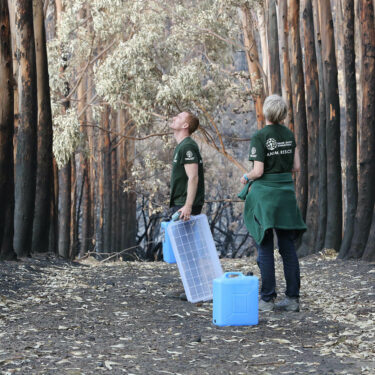
Photos: Jo-Anna Robinson/AAP Images for HSI
How many trips have you and your team had so far?
Evan: I’ve personally made three trips to Kangaroo Island so far this year, but as for how many the team has done it’s difficult to say as there was intentionally a lot of overlap! After Erica, Kelly and I got there on the 10th, we got to it on our own for around a week before more staff from both our Australian office and the US arrived. There were eight of us doing search and rescue in three vehicles for another week before we started rotating out, but aside from a short period in late January and the start of February we’ve had a constant and evolving presence on the ground.
Have you been working in other locations?
Evan: Kangaroo Island was the only location where Humane Society International staff were directly conducting wildlife search and rescue during the bushfire crisis, but we also made trips to visit wildlife carers around Canberra and other regions to see how we could be of most assistance. This went hand-in-hand with the majority of our urgent bushfire response work around the country which focused on building the capacity of and covering urgent costs for established wildlife carers, many of whom are connected to Humane Society International through our Wildlife Land Trust program, through emergency grants.
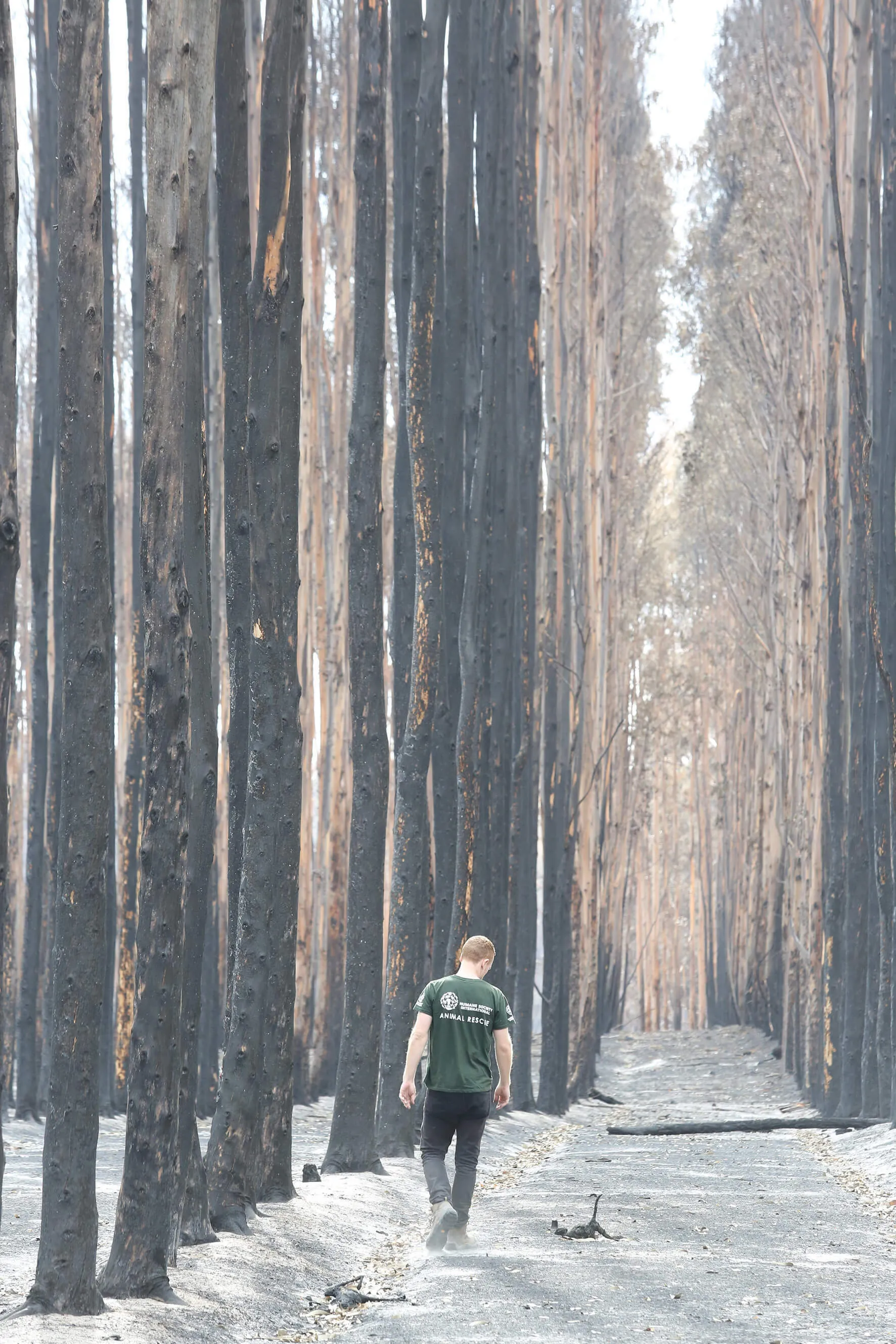
How different has the experience been to what you anticipated? Was it even possible to anticipate?
Evan: I don’t think it’s possible to prepare yourself from something like what we went through unless you’ve already been through it... I knew that there were estimates of tens of thousands of koalas, wallabies, kangaroos and other wildlife being killed in the Kangaroo Island fires, along with tens of thousands of sheep and other livestock that had the broader community reeling, but the reality of that situation is very difficult to describe. We dubbed one of the first and eventually the most regular plantation we visited ‘Hell’ and it was honestly nothing short of apocalyptic. A dead koala marked the entrance from the highway and as soon as we left the road we had to drive carefully through a mob of about fifty Tammar wallabies that had died while trying to flee the plantation—the scale of their burns lessened as the bodies progressed from the edge of the plantation up until some of those that had made it that far got stuck in a fence... but none of them made it. As we walked towards a clearing there was an incinerated koala body at least every ten metres, and once we got there it was overwhelming to say the least—possums, kangaroos, wallabies, koalas, goannas and everything in between had clearly headed there in desperation, but the heat was just too intense and these animals that would normally keep a wide berth from each other all died together.
And that’s just dealing with those animals that had already died. The ongoing pain of many of the survivors was extremely confronting. Kangaroos with curled back bones for paws that had been lying starving and in pain for days, joeys that needed to be taken from their mothers because their legs were infected and rotting off... it was a lot, and most of our drives were made in complete silence while we tried to keep animals calm and processed the horrific things we were all being exposed to.
We were easily putting in 140+ hour weeks, no stopping for weekends and never stopping. It took a serious physical and mental toll, but the team was incredible and we somehow kept each other going.
I don’t think it’s possible to prepare yourself from something like what we went through unless you’ve already been through it... I knew that there were estimates of tens of thousands of koalas, wallabies, kangaroos and other wildlife being killed in the Kangaroo Island fires, along with tens of thousands of sheep and other livestock that had the broader community reeling, but the reality of that situation is very difficult to describe.
Evan Quartermain
Tap to explore content
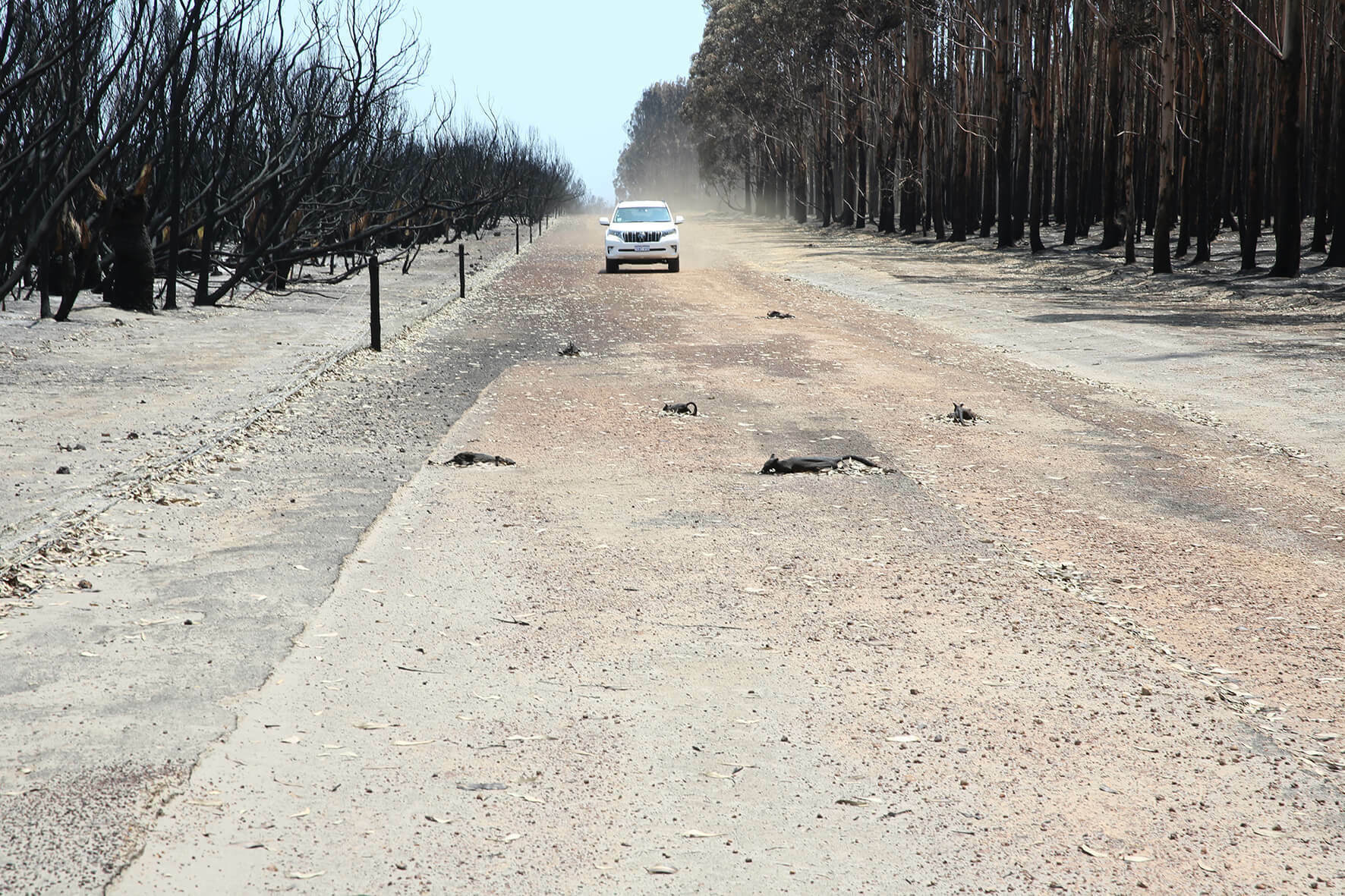
Photos: Jo-Anna Robinson/AAP Images for HSI
Do you think the wildlife population on Kangaroo Island will be able to recover from the devastating fires?
Evan: Not ever as it was, with it highly likely that several species were wiped from the planet forever during the fires. Some iconic species like the Kangaroo Island dunnart are now on their last legs and their role in the recovery will be all but absent, and particularly in the Flinders Chase National Park there are concerns that the fire was just too intense for even species well adapted to it to survive. Seedbanks that are usually relied on may have been completely obliterated from some areas.
But on the second and third trips, it was clear that ecosystems were recovering, with epicormic growth bursting from blue gum trunks in the plantations and vibrant greens sprouting from blackened trees and grass tree trunks. Kangaroo Island is well known for its abundant wildlife, and in time signs are pointing to it recovering to be close to what it was. I feel a real connection to the place now, and its beauty is undeniable, so I’m looking forward to visiting regularly and seeing it bounce back.
What are some of the things that happen on a wildlife rescue trip?
Evan: A lot of driving, a lot of walking through devastated landscapes scanning for life, and not much sleeping or eating. Immediately after and even during the fires we were driving to places of particular need that we’d located, finding as much wildlife in need of help as we could—which ended up mostly being koalas—and getting them to the Kangaroo Island Wildlife Park for veterinary assessment as soon as possible. Then it was back on the road for another run, over and over.
It was quite remarkable to see how that side of things progressed. The first koala we brought in was taken to a couple of Defense Force vets operating out of a small shed at the Wildlife Park, then the next day a pop up veterinary tent was set up by SAVEM and more vets brought in, and it got more and more professional every day. Space to take the recovering koalas too quickly became a problem, and Humane Society International was fortunately able to provide funding for materials to build more pre-release enclosures. Quite inspirational to see how people from all walks of life worked together in the best interests of the wildlife needing help!
As time went on our search and rescue efforts shifted from burns victims—which were typically on the ground—to koalas starving in small patches of vegetation that had partially survived the flames. This meant more time was spent searching as the animals were fewer, and once the patches were located we would set up water stations and map the number of koalas and their priority for rescue—an estimate of their condition and how much food was present—so we could work with arborists and other rescuers to get them the help they needed.
On the second and third trips, it was clear that ecosystems were recovering, with epicormic growth bursting from blue gum trunks in the plantations and vibrant greens sprouting from blackened trees and grass tree trunks. ...I feel a real connection to the place now, and its beauty is undeniable, so I’m looking forward to visiting regularly and seeing it bounce back.
Evan Quartermain
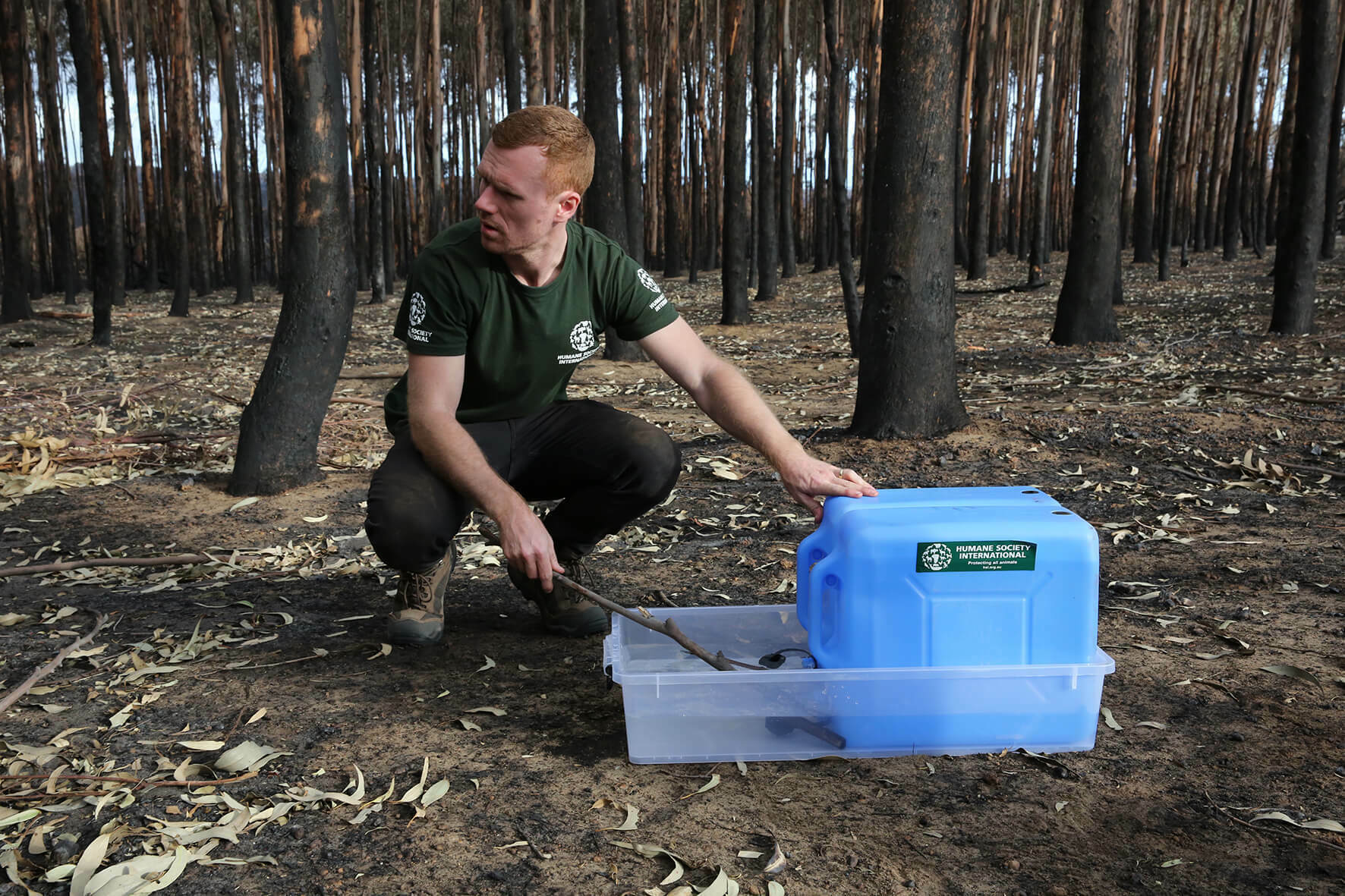
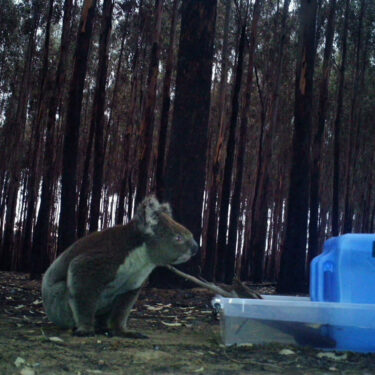
Photo: Jo-Anna Robinson/AAP Images for HSI
What kind of technology do you use during the rescue missions?
Evan: On the first deployment our primary means of supporting surviving wildlife and prioritising areas to return to was establishing water stations and using wildlife cameras to document their use. We would use a tray that fit two 20 litre jerry cans snuggly to make 40-litre water stations that automatically refilled, and attach motion-activated cameras to trees nearby which we would check on regularly. They were fairly simple cameras—ScoutGuard SG860Cs—that we’ve used for various monitoring purposes over the last five years, but proved invaluable in shaping our response on the ground and were very quick and easy to use. I will never forget finding that a koala had climbed down for a drink when checking on the first one that we placed! It felt amazing to be able to provide for these animals in need even when we weren’t there, and gave us hope that we could keep them going for at least a few more days and give us a chance to rescue them.
After we moved to the second stage of looking for patches of surviving koalas, it quickly became evident that walking and driving through often completely burnt plantations wasn’t the most efficient use of our time. It was of course still extremely worthwhile as on several occasions we found lone koalas on their last legs, but we were acutely aware that there were 18,000 hectares of plantation on the island and it was going to take us a long time to get to them all. We’d been contacted by Douglas Thron—a drone pilot from the US—who was offering his services and cutting edge infrared drone technology that could be used to scan the plantations and identify surviving wildlife much faster than we could have otherwise, so we jumped at the chance.
Douglas can you tell us a little bit about how you found yourself working in this field?
Douglas: I’m an outdoor aerial cinematographer and I shoot for TV shows like Nat Geo and Discovery. I was out in the Bahamas filming after the hurricane and was finding dogs that needed rescuing with my drone. The rubble from the destroyed houses was so high—up to 30 feet tall—and it was hard to find the dogs, even with the drone.
And this is where I got the idea to test if the technology of infrared drones was good enough for that application. So I went back to California, got a custom made infrared drone, and tested it out looking for dogs. It worked so well out there. I was out there for a number of months rescuing animals, and when I saw videos of koalas needing rescue out here, I basically moved from Bahamas to California, stopped for about a week, and then came out to Australia and started rescuing koalas in around mid-January.
That's incredible. I bet the team were pretty excited to hear about the technology.
Douglas: Yeah, it works exceptionally well. I mean, it was trial and error at first, finding dogs in the Bahamas was definitely easier than finding koalas way up in trees in a dense canopy.
I used custom spotlights and an infrared camera that moves simultaneously with the drone. On the second camera mount, I had a 180 times zoom lens, that I can switch back and forth with to verify whether what I’ve found is an animal or not. And then if it is an animal, what the condition of the animal is.
How long were you on Kangaroo Island?
Douglas: I was there for almost three weeks and in that time, I estimate that there were around 70 koalas that I helped save.
With a drone, you can spot koalas better than anything from the ground. But it's not easy. You see, koalas show up as hot, but so do certain tree branches and ground and other things, so it definitely takes some trial and error getting used to finding koalas.
When you’re using an infrared camera, reading what the results are is kind of like riding a bicycle. It's not easy in the beginning, but once you get it down then you're good to go. There was definitely a really steep learning curve involved.
The drone that I used, plus all the equipment, is as expensive as a two-seater aeroplane. So there's nothing cheap about it. So you have to really know what the heck to do on the sideline because that's a lot of money. The drones are not forgiving. If you nip a little bit of a tree branch, you're likely to crash it real quick.
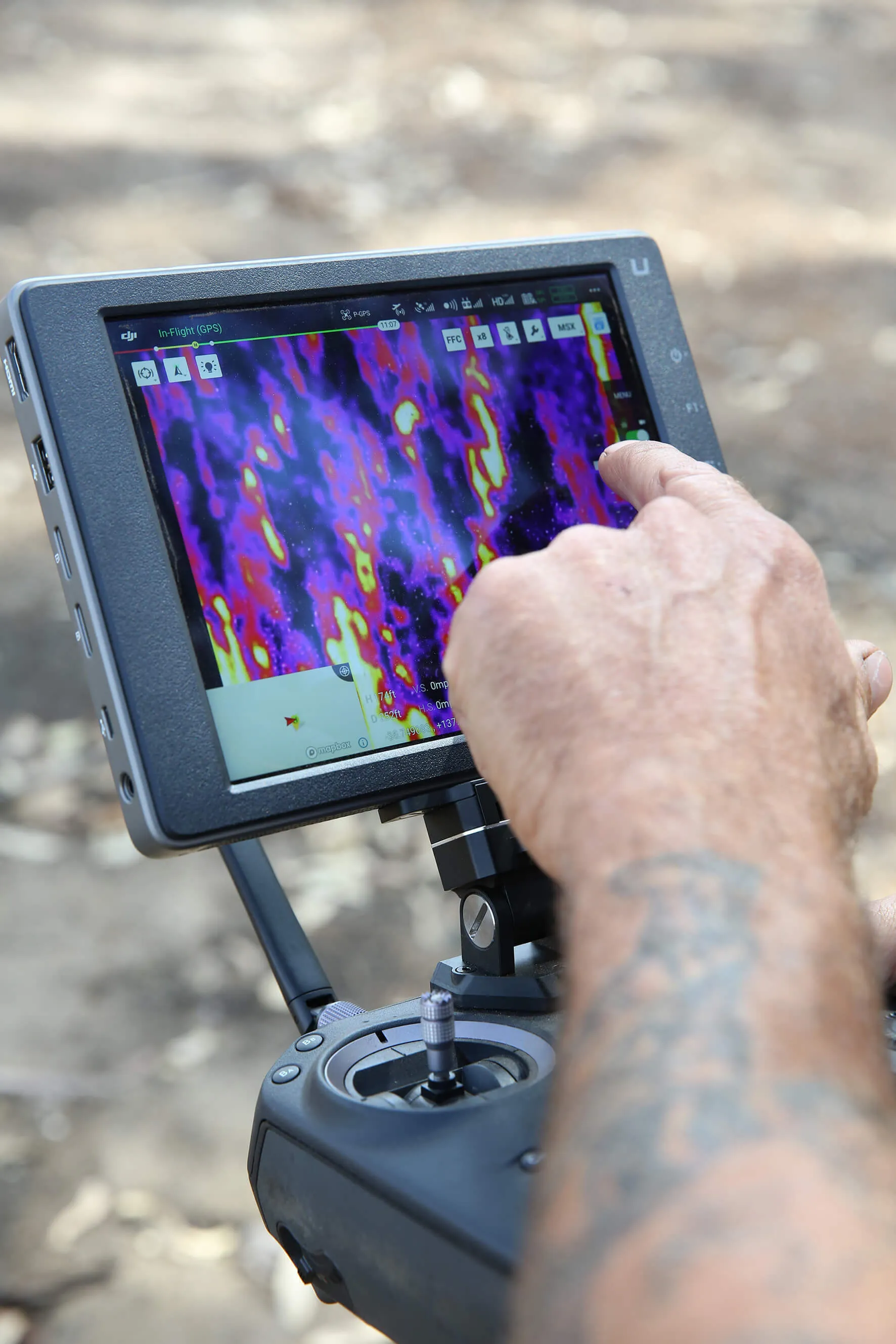
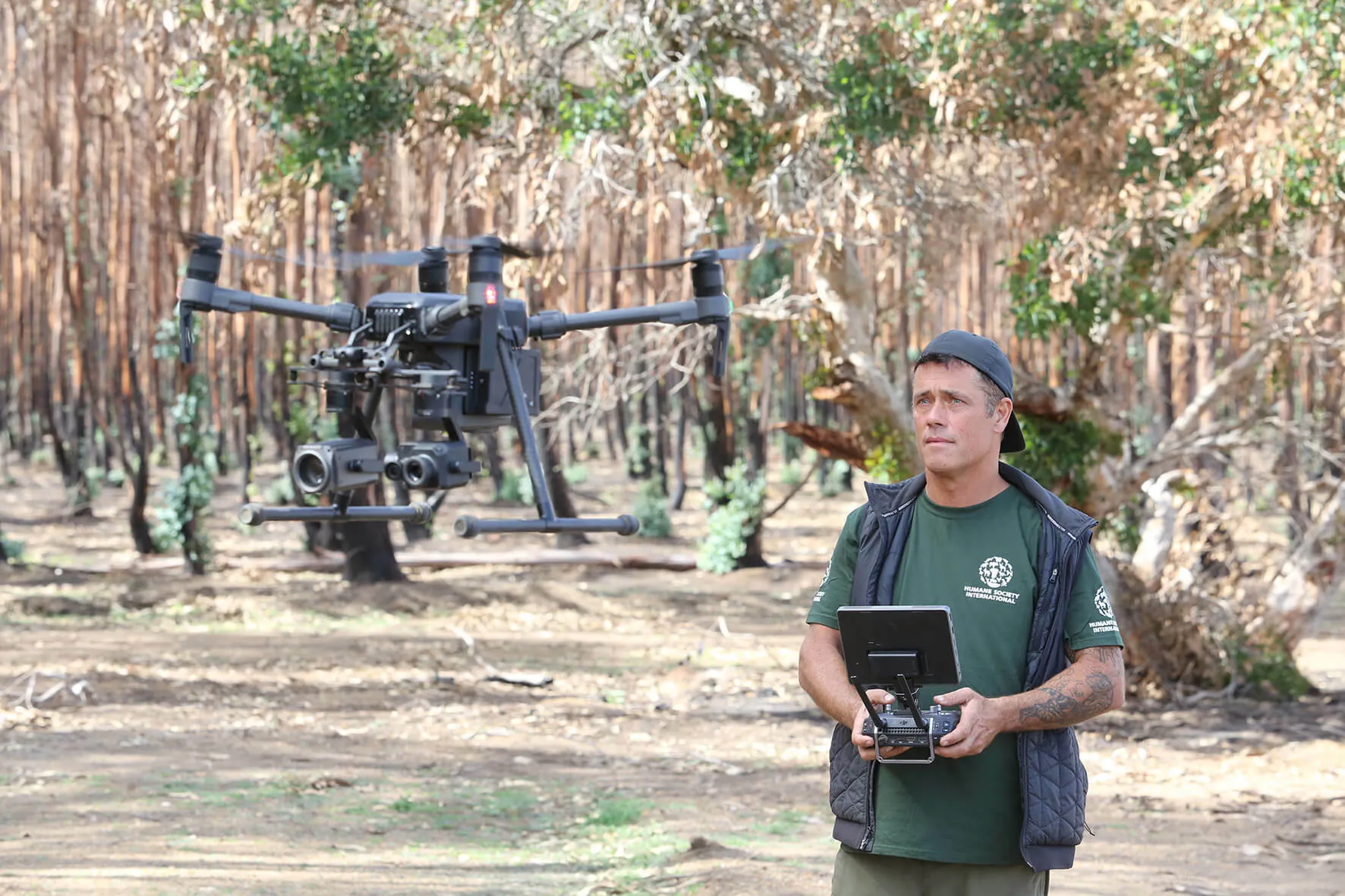
I have no doubt! Is there a particular rescue that stands out as your favourite?
Douglas: One rescue certainly stands out.
I was working with a number of different individuals—tree climbers and people that would trap them—and because the rescue team was so excited to see the drone working, three or four koalas got named Douglas after me!
But yeah, there was a baby one in particular that we were able to put a trap down for, that was super warm, fuzzy, and cuddly. And that one, of course, sits in my memory most because I was holding it in my arms.
In the media you see Koalas that are warm and fuzzy. But most of them are not so warm and fuzzy. You're pulling them out of a tree and relocating them or they’re injured and you’re trying to get them to a safe place. So they'll make a hell of a lot of noise screaming and clawing and trying to bite.
How much longer are you going to be in Australia for and what are you hoping to work on next?
Douglas: I'm planning on staying here. There's a tonne of work to be done, it kind of feels like the battleground for climate change and protecting the environment.
My hope is two-fold. I came here to save the animals in immediate danger and my bigger hope is that other people who are skilled drone pilots will get inspired to do this, and larger environmental groups will pressure the government to do this and use it as a common practise for rescuing our endangered wildlife.
It just shaves off so much time and results in so many more animals they can save so I'm hopeful that one day this will be as common as the helicopter being used to rescue people. It's relatively cheap compared to helicopters and used in conjunction with rescue crews on the ground, it's an unbeatable team.
This is a really exciting development in wildlife rescue. Thank you for all of your work, Douglas. Evan, can you tell us what value this approach added to your rescue trips, from your perspective?
Evan: Working with Douglas and having his drone and its cameras available changed the game for us. It meant we could cover much greater areas, more comprehensively, thanks to the infrared camera. And once koalas were located the zoom lens often gave us a great indication of their condition and any burns present; essentially helping us to determine how urgent their rescue was.
I’m interested to hear about your favourite rescue so far.
Evan: Across our trips, Humane Society International was involved in the rescue of around 100 animals including koalas, kangaroos, wallabies and echidnas, but there are two in particular that have really stuck in my mind for whatever reason.
My guy
On the last day of my first two-week deployment I’d well and truly hit a wall and was driving back to base on my own to book a flight home when I saw a koala on the side of the road. I could see an exposed rib and a lot of swelling as he hobbled a few metres away, possibly hit by a car some time ago and now starving and infected.
As I’d just emptied all catching supplies aside from a towel into another car for those still out doing rescues there wasn’t a lot to work with, but I managed to bundle him up and get back to the clinic where they quickly anaesthetised him to take a look. Those were to be his last moments of consciousness, as when the vets turned him over it was obvious straight away he had next to no hope of survival. They ended his suffering then and there.
It was a hard hit to take and I may have had a bit of a moment when one of the vets said some lovely things and gave me a hug, but I'm so glad he crossed my path. The euthanasia cases honestly felt just as meaningful as those for koalas that made it, which I guess makes sense considering we were there to reduce as much suffering as we could. I think this koala was the only one we didn’t name on the whole trip... I just think of him as my guy.
Skylah
Bringing Skylah in was really something special. Erica somehow spotted her defeated at the base of a tree as we were checking on a water station and wildlife camera on our last plantation walk for the day on our second deployment, and after a careful approach—trying not to startle her through a sea of crunchy leaves—and smooth capture we thought she'd died on Georgie's lap on the way to the Wildlife Park.
There was nobody around when we arrived so we were really fearing the worst, but as I carried her in she sparked to life and in true tough koala style had a go at me. Spirits immediately lifted and we got her into an enclosure where we'd put water and plenty of blue gum to last her through the night, filled out some paperwork and messaged Sam the park owner so everyone knew what was going on. Stood back quietly for a bit and our hearts soared when she started smashing leaves down with gusto and climbing all over the place. We had a big team hug and left her to it.
We checked in to update the search map the next morning and Jenny—one of the vets—asked if we knew who'd brought in the koala at 8pm the night before. Sheepishly and worriedly we admitted it was us, but got the great news that we'd done the right thing and other than being near death through starvation Skylah was well enough to be given a chance.
Saving a dying koala and seeing her bounce back so fast was up there with the best feelings in the world, and was much needed in between a lot of exhaustingly tough and dark moments. We were really looking forward to seeing how she was going when we got back on the island for the third time, but just days before our arrival we received the gutting news from the vets at the Wildlife Park that she’d taken a turn for the worse and hadn’t made it... Yet another one without a happy ending, but we’re so glad we were able to bring her comfort in her final days.
Saving a dying koala and seeing her bounce back so fast was up there with the best feelings in the world, and was much needed in between a lot of exhaustingly tough and dark moments.
Evan Quartermain
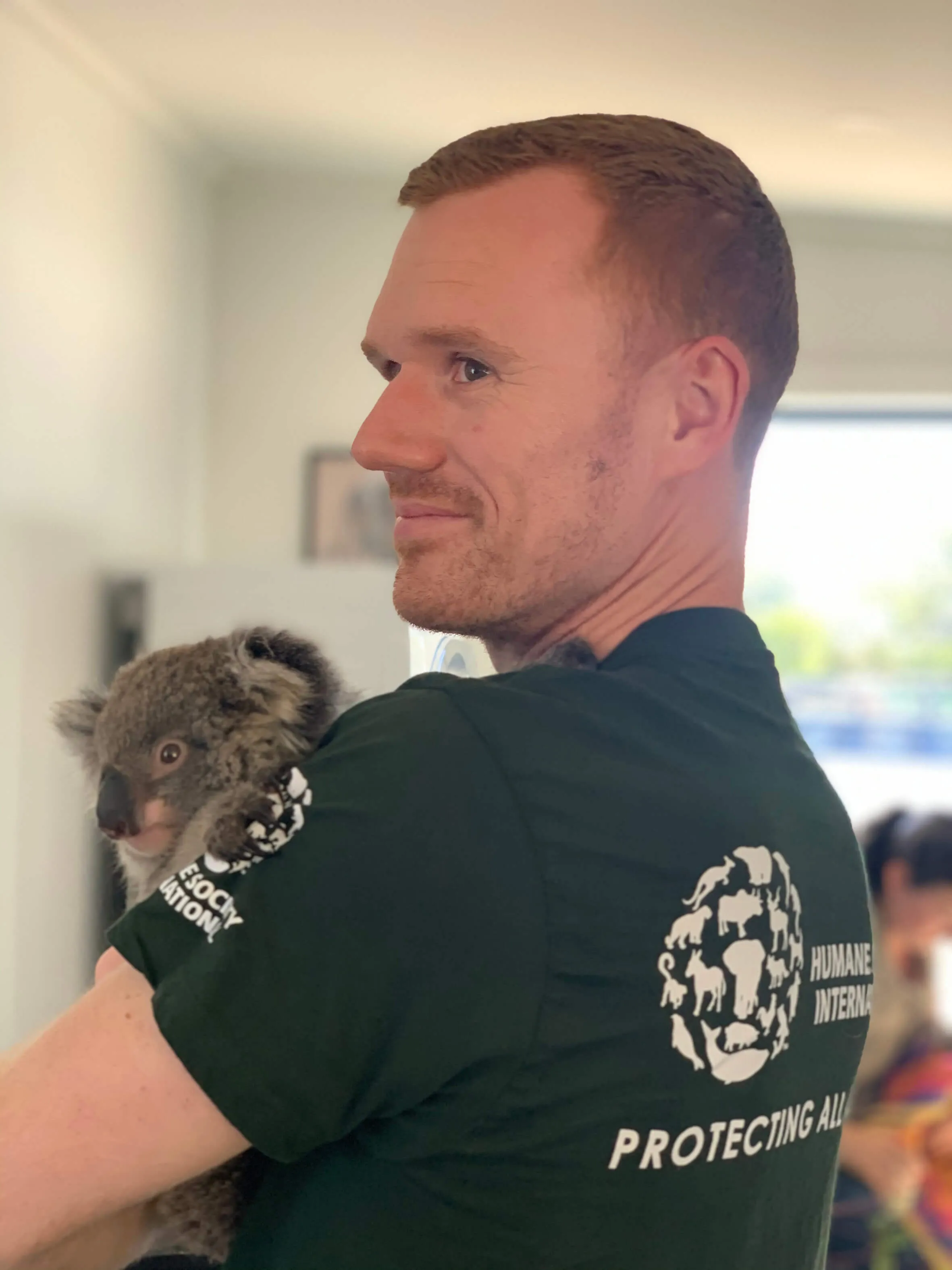
Tap to explore content
Is there anything else you would like to share that we haven’t covered?
Evan: My involvement in wildlife search and rescue on Kangaroo Island was a real eye-opener... I’ve worked on wildlife and habitat protection issues for more than a decade, but never before has it been so clear how urgent greater action on the threats of habitat destruction and climate change are. There’s quite simply no time to waste in changing our ways and living more harmoniously with nature. These devastating events are getting more severe and frequent, and the suffering they cause is overwhelmingly immense. I was acutely aware of that already, but it took seeing it in person to really bring the message home.
It was the toughest, most devastating time of my life, as well as the best thing I've ever done, and I’m determined to use the experience as best I can to make a difference.
If you would like to support the critical and life-changing work of Humane Society International Australia you can make a donation on their website .
Photos: Erica Martin, HSI and Georgie Dolphin, HSI
I’ve worked on wildlife and habitat protection issues for more than a decade, but never before has it been so clear how urgent greater action on the threats of habitat destruction and climate change are. There’s quite simply no time to waste in changing our ways and living more harmoniously with nature.
Evan Quartermain
